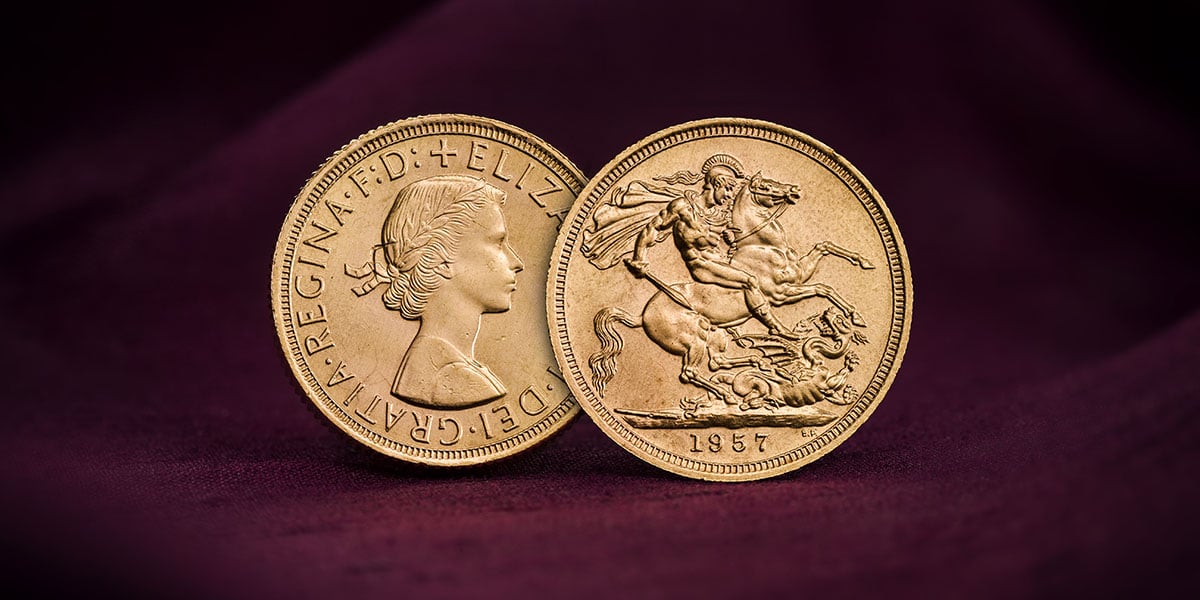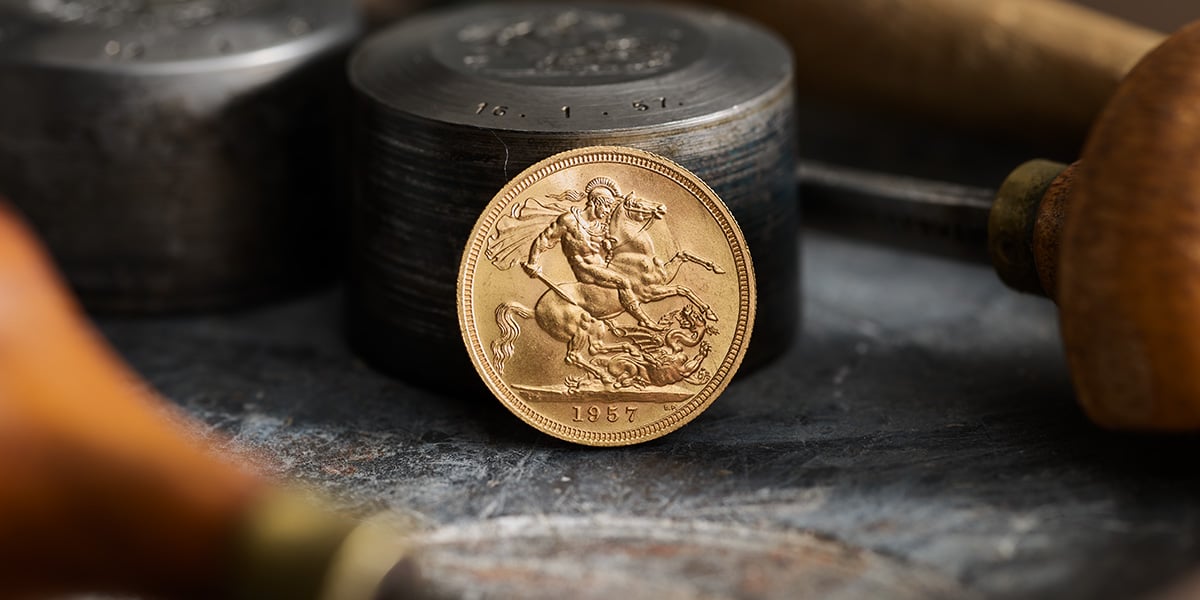An original Sovereign, struck over 60 years ago
The year 1957 saw many 'firsts' for Her Majesty The Queen. She made her first state visit to the United States of America and the Christmas Message was aired on television for the first time. This year also saw a first for The Queen's coinage as Sovereigns were struck again after a break of almost 20 years.
This coin was the first mass-produced, 22 carat gold Sovereign of Her Majesty's reign. It features the first coinage portrait of Queen Elizabeth II by Mary Gillick on the obverse and the famous St George and the dragon design by Benedetto Pistrucci on the reverse.
Introduced in 1817, the modern Sovereign has featured coinage portraits of ten British monarchs on the obverse, including several depicting Queen Elizabeth II, the longest-reigning monarch in British history.

During Elizabeth II’s reign, the year 1957 heralded a pivotal moment in numismatic history as it saw the reintroduction of regular Sovereign production after nearly two decades of dormancy. Amidst the backdrop of evolving economic landscapes and shifting global dynamics, The Royal Mint began to produce this revered symbol of British numismatic heritage once again.
The Decline of The Sovereign
The economic difficulties of the First World War marked the end of the golden era of The Sovereign. In 1914, as the world plunged into the maelstrom of the First World War, George V found himself at the helm of a nation in crisis against the backdrop of profound societal upheavals and global conflict. As a result, a nationwide campaign took place encouraging citizens to invest their gold in order to aid the war effort, with Treasury notes being issued for circulation instead of gold coins.
The summer of 1915 witnessed the disappearance of gold from circulation, which led to the end of Half-Sovereign production in London the same year. By 1917, regular Sovereign production, once the epitome of numismatic excellence, had ceased in London.
In 1925, Winston Churchill in his post as Chancellor of the Exchequer reintroduced the gold standard in the United Kingdom, but this did not trigger the reissue of gold circulating coins. Instead, the opportunity was taken to recoin a quantity of light gold that had accumulated at the Bank of England, after which the minting of gold coins stopped. Churchill’s limited gold standard proved to be unfeasible and in September 1931, the newly formed UK Government and Ramsay MacDonald, then Prime Minister, had to abandon gold coinage due to an economic crisis.
By this time, the Bank of England had already converted a significant portion of its Sovereigns into standard gold bars. It was also during this period that our overseas branch mints stopped minting coins in The Sovereign family. In Australia, minting ceased in 1931, whilst in South Africa it stopped the following year. The year 1933 marked the first in nearly a century in which no Sovereigns were struck anywhere in the UK or Commonwealth.
A Global Demand
Despite the cessation of minting, Sovereigns continued to be involved in the international movement of gold, with a continuous flow remaining between London and other financial centres. Due to their precise weight and fineness, Sovereigns remained a favoured coin with a consistent demand internationally.
The continuing popularity of The Sovereign in the disturbed financial conditions of post-war Europe resulted in the coin developing a premium over and above its bullion value. This attracted high-quality counterfeiters, some of whom even set up fully-equipped factories and established well-organised distribution networks that extended to countries such as Switzerland, France, Germany and Greece. Some counterfeit coins were also distributed to Beirut in Lebanon for further distribution throughout the Arabian Peninsula, East Africa and the Far East.

In 1957, the UK Government resumed the regular production of Sovereigns in response to a growing demand made evident by counterfeiters’ success. As a result, the 1957 Elizabeth II Sovereign was created as a testament to the integrity of British currency.
Early Sovereigns of Elizabeth II’s Reign
In 1952, the young Queen Elizabeth II sat down opposite Mary Gillick to have her profile immortalised as a coinage portrait for the first time.
The 1957 Sovereign became the first bullion Sovereign of Elizabeth II’s reign, and the bust used for this second issue was once again the work of Mary Gillick. However, the legend ‘BRITT: OMN:’ that was present on the 1953 Proof coin was omitted from Queen Elizabeth II’s titles owing to the changing status of many Commonwealth territories. This currency issue continued to be struck until 1968.
Since its revival in 1957, more than 80,000,000 Sovereigns have been struck, each identical in size and weight to the first modern Sovereigns of 1817. Like their predecessors, they proudly bear Benedetto Pistrucci’s classic St George and dragon design on the reverse. In 1979, the coin was complemented by a special issue of Proof Sovereigns for collectors. The success of this endeavour led to its repetition each subsequent year, thus solidifying The Sovereign’s continuous presence outside of the UK’s circulating currency.
Specification
| Specification | Value |
|---|---|
| Denomination | Sovereign |
| Alloy | 22 Carat Gold |
| Weight | 7.98 g |
| Diameter | 22.05mm |
| Reverse Designer | Benedetto Pistrucci |
| Specification | Value |
|---|---|
| Obverse Designer | Mary Gillick |
| Quality | Circulating |
| Year | 1957 |
| Pure Metal Type | Gold |
